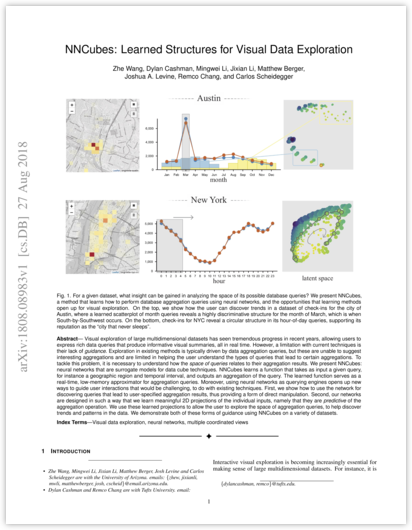NNCubes: Learned Structures for Visual Data Exploration
Zhe Wang, Dylan Cashman, Mingwei Li, Jixian Li, Matthew Berger, Joshua A. Levine, Remco Chang, and Carlos Scheidegger.
Visual exploration of large multidimensional datasets has seen tremendous progress in recent years, allowing users to express rich data queries that produce informative visual summaries, all in real time. However, a limitation with current techniques is their lack of guidance. Exploration in existing methods is typically driven by data aggregation queries, but these are unable to suggest interesting aggregations and are limited in helping the user understand the types of queries that lead to certain aggregations. To tackle this problem, it is necessary to understand how the space of queries relates to their aggregation results.
We present NNCubes: neural networks that are surrogate models for data cube techniques. NNCubes learns a function that takes as input a given query, for instance a geographic region and temporal interval, and outputs an aggregation of the query. The learned function serves as a real-time, low-memory approximator for aggregation queries. Moreover, using neural networks as querying engines opens up new ways to guide user interactions that would be challenging, to do with existing techniques. First, we show how to use the network for discovering queries that lead to user-specified aggregation results, thus providing a form of direct manipulation. Second, our networks are designed in such a way that we learn meaningful 2D projections of the individual inputs, namely that they are predictive of the aggregation operation. We use these learned projections to allow the user to explore the space of aggregation queries, to help discover trends and patterns in the data. We demonstrate both of these forms of guidance using NNCubes on a variety of datasets.
